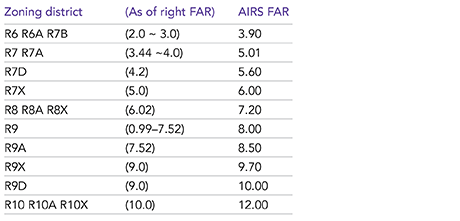Land Use and Zoning News
September 14, 2017
AIRS. Better than Heirs. Almost as good as air rights!
By Jessica Loeser, GH Special Counsel
It’s almost trite to say that there is an unmet need for senior housing throughout New York City. In an effort to encourage housing for seniors, the City (through the City Planning 2016 major overhaul of the Zoning Resolution, ZQA) has created two new opportunities for a Floor Area Ratio (FAR) bump for providing housing specifically for seniors. These changes encourage new homes for seniors, as well as the rehabilitation and preservation of existing senior developments.
Affordable Independent Residences for Seniors (“AIRS”) applies to developments citywide, and replaces what was previously called “non -profit residence for the elderly” and are Use Group 2 (“UG2”). This change allows a wider range of not-for-profit and for-profit entities to develop and preserve affordable senior housing.
To qualify for the AIRS FAR bump units must be occupied by at least one person who is 62 years or older and a minimum of 4% of the space in the building has to be dedicated to shared facilities for residents, like dining rooms and community rooms. What remains consistent with existing senior housing programs is the age of the residents and income restrictions (seniors with incomes within 80% AMI or below, 30 year term).
The bulk benefits of a qualifying AIRS building can be found in a greater FAR, a higher building heights and open space ratios. Additionally, there is a lower “dwelling units factor” that allows for, in higher density areas, a slightly greater number of apartments to be included in the development (see chart below).
Long Term Health Care Facilities
Another new option available for developing senior housing is something called Long Term Care Facility (“LTCF”), which is an effort to make it easier to develop housing to meet the different levels of care that seniors require. This new category of housing covers everything from what we currently call assisted-living facilities, nursing homes, and continuing care retirement communities; while also creating flexibility for a potential future model for senior housing. Long Term Care Facilities are licensed by the State, Use Group 3 (“UG 3”), and are now as-of-right in most residential districts. Though LTCFs are UG3, the new regulations allow greater flexibility of combining UG 2 and UG 3 uses within the same development and on the same floor. This fluidity of senior housing needs and the types of care that seniors need, addresses an important need for flexibility that has been absent in our housing stock.
Like AIRS, LTCFs also enjoy an as-of-right bump up in square feet, height and a reduction or elimination of parking requirements.
More Bulk
For both AIRS buildings and LTCFs located in lower density zoning districts, the FAR bump is identical
In medium to high density zoning districts, AIRS and LTCFs are required to use Quality Housing design to better utilize the higher available FAR.
For example:
Additionally, AIRS and LTCFs get taller building heights:
10’ (1 story) in R6A, R7A, R7D Districts
20’ in R7X, R8A, R8X, and R10A Districts (on wide streets)
30’ in R9A, R9X and R10A Districts (on narrow streets)
Additional base heights in step with changes to overall heights
Higher ceiling heights on ground floor (13’ to second floor, no use restrictions)
Ground floor obstructions in the rear yard for accessory uses (cafeterias, laundry, etc.) permitted on wide streets and in Commercial Districts
Less Parking
The ZQA also expanded the “transit zone” in the City and for AIRS or LTCFs developments within the Transit Zone parking requirements have been removed. This change will have a tremendous impact on the development of new senior housing and the preservation of existing senior housing. Existing AIRS or LTCF may develop their underutilized parking facilities (with the new more generous bulk regulations) provided that the developments further the creation or preservation of affordable housing on the site.
These zoning changes hope to encourage the development and preservation of additional senior housing units to help seniors age in place. If you have any questions about the programs mentioned above, feel free to reach out to Jessica.
Land Use and Zoning News
May 9, 2018
The Hudson Valley Affordable Housing Summit: Novel Strategies for Novel Times
September 14, 2017
Land Use and Zoning
October 13, 2016
Goldstein Hall is pleased to welcome Jessica T. Loeser as Special Counsel to our firm
September 28, 2016
Goldstein Hall Educational Seminar Series: Mandatory Inclusionary Housing & Zoning for Quality and Affordability







